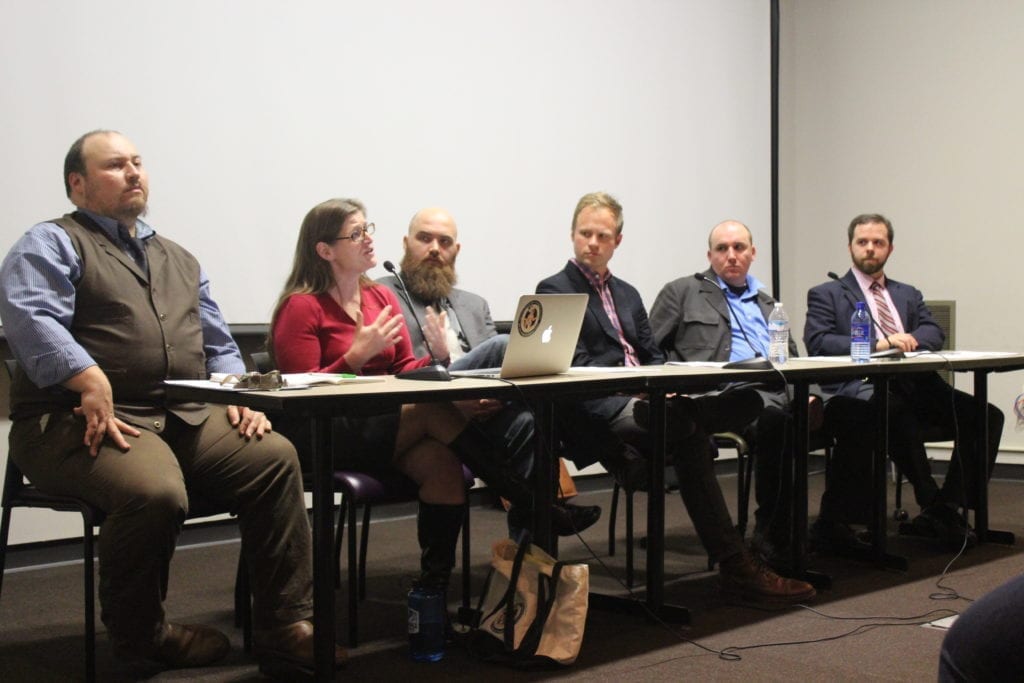The 2016 election through the lens of history
Does history really repeat itself? A scholarly panel draws historical parallels to the modern election.

Pictured (L to R): Bob Hutton, Julie Reed, Josh Hodge, Tore Olsson, Brad Nichols, Max Mather
On Thursday, Jan. 19, the eve of President-Elect Donald Trump’s inaguration, students filed into Lindsay Young Auditorium for a symposium discussing the 2016 election cycle with a historical perspective.
Six historians from various fields presented points that debunked the popular media notion that the election was “unprecedented.” Though social media ramped up the buzz of the election, political strife has been a hallmark of the American story.
“Fake news and political propaganda are as American as apple pie,” senior lecturer Bob Hutton said, noting that media, as we know it, was initiated by political parties to circulate information about rivals.
Lecturers focused on historical instances that resemble the rhetoric of the U.S. election cycle. Topics included mass deportations, a border wall, the evolution of the Republican Party and Andrew Jackson to name a few.
Bob Hutton, Senior Lecturer—Evolution of the Republican Party through the 20th Century:
According to Hutton, despite the fact that Republicans continually tout their affiliation with Lincoln and the abolition of slavery, it may not be enough.
“There is only so much you can claim from ancient party actions,” Hutton said.
He highlighted the strange dichotomy of the current GOP shift from their 20th century internationalism to their 2016 policy reversal of nationalism. This may reflect a new global trend in “Paleo-conservatism,” a name given to those of with extreme right wing notions.
Hutton continued to invoke the adage “how the times have changed” as he went on to discuss the fiercely debated topic of illegal immigration. The undocumented citizen discussion was renewed with fervor in the 2016 election it had not seen since the days that Ronald Reagan, a historically hailed Republican, encouraged the Amnesty Bill and immigration itself.
Julie Reed, Assistant Professor—Forced Native American removal:
In her experience with Indian Removal Reed witnessed the social consequences of removal.
According to Reed it “hurts families” and “damages communities.” She reasoned that removal disproportionately hurts already vulnerable members of the population, sometimes even ripping families apart.
“People justify removal as humane and a better option than others…We can convince ourselves of a lot of things when we want to believe we’re doing the right thing. Seemingly good people will do nothing as it happens,” Reed said, recognizing the “disparagement” of the Native American population.
“They [Native Americans] are a fraction of the number of people that Trump has proposed deporting,” explained Reed.
Josh Hodge, PhD Candidate—Analogies between the reconstruction period and the present:
The number of hate groups in America has been on the rise since the beginning of the 21 Century, with 892 operating groups in existence according to Southern Poverty Law Center’s “Hate Map.”
Hodge pinpointed the white supremacy as an age old and evasive force of oppression. He reasoned that though the U.S. elected its first black president, it still has miles to go; Race continues to be an issue.
Hodge isolated the Klu Klux Klan to illustrate the influx of hate groups near situations of intense social progress. They published more than 3,000 articles between 1866 and 1873 as a result of the Civil Rights Act.
“Here’s the point,” Hodge said. “We shouldn’t be surprised if there is a white backlash to the first black president, we should remember that things aren’t as bad as they once were, recognize white supremacy is a tradition that dies hard. We have to stand against it…”
Tore Olsson, Assistant Professor—Political Implications of the shared history of between the U.S. and Mexico:
Olsson rationalized the hopeless entanglement of American and Mexican affairs since the founding of each nation.
The U.S. and Mexico initiated the “Bracero Program,” a pact of diplomatic laws to encourage more Mexican immigration to increase the farm laborer for Southwestern agribusiness corporations.
Though they were once warm allies and kindred spirits, the Mexican-American war muddled the civilities. Perpetuating more muddled water, Trump has repeatedly called Mexicans “rapists” and “murderers,” while pointing the blame at them for “killing” America’s economy.
The North American Free Trade Agreement that Trump has repeatedly cited as detrimental has also kept a chokehold on the Mexican economy in many ways.
According to Olsson, it is a “gross oversimplification” to view NAFTA as having a clear “winner” or “loser” as it positively and negatively affected both economies.
“If anyone would’ve wanted a wall,” Olsson said, “it would have been the Mexicans.”
Brad Nichols, Lecturer—Violent Attempts at forced deportation in 20th century Europe:
Nichols was quick to bring light to the election cycle’s burning question: “What do we do with 11 million undocumented immigrants?”
With Hillary Clinton, the Democratic nominee, endorsing amnesty and the President-Elect Trump advocating for deportation, Nichols called it “disturbingly ominous” and “eerily reminiscent.”
“I’m not saying this is what’s going to happen…but I do think we need to reflect on what could happen in light of what has transpired in the past when societies endeavor to remove a sizeable group of people from their midst.”
Though Nichols acknowledges multiple possible stories that offer cautionary tales he chose Eastern Europe’s massive expulsion of Germans after World War II. Eastern Europe deported nearly 8 million Germans in an ethnic-cleansing retaliation to Nazi actions.
According to Nichols, German deportations were successful because they operated on a logic aimed at “dehumanizing” Germans in the name of social justice. They were branded as “economic parasites that sucked up vital resources” or as “conniving loafers who stolen jobs.”
He noted that the deportation caused mass economic shock to Europe in their scramble to replace thousands of skilled workers they exiled from their borders.
“Forced relocation on a massive scale almost entails catastrophic loss of life,” Nichols said. “It is very difficult for modern American’s to wrap our heads around the notion that we might be capable of committing similar [to Nazis] types of atrocities.”
Max Matherne, PhD Candidate—Analogies between Andrew Jackson and Donald Trump:
Matherne began by laying the groundwork for who could possibly be deemed the most qualified president in history with prior legislative experience in congress and a familial ties to a presidential legacy: John Quincy Adams.
Despite his impressive list of merits, he was beaten out by a “brash” outsider with an authoritarian streak that promised to “clean Augean stables” and rid the government of corruption. Adams was beaten by Tennessee’s leading man, Andrew Jackson.
Matherne stressed the fact that many of Jackson’s staunchest supporters rejected his Native American removal policies but voted for him anyway in a “fingers crossed” hope of good behavior as if they possessed a line item veto policy by policy.
Jackson, along with Trump, promised to speak “for the people,” leaving Matherne asking “Who are ‘the people’?”
“Which of us is among “the people.” Who gets to be counted as more American than their neighbor?” Matherne asked the audience. “Ever since Jefferson moralized the words ‘all men are created equal,’ we’ve been adding footnotes and fine print to that word, equal, to determine the exact degrees and equality in American democracy.”
Featured Image by McKenzie Manning
Edited by Kaitlin Flippo

